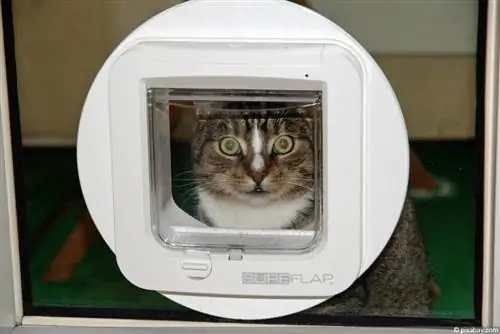- Author admin [email protected].
- Public 2023-12-17 03:39.
- Last modified 2025-01-24 12:45.
Cats hunt mice. It's just a shame that cats love to present their prey to their owners. That's why many a dead or still living mouse has ended up in the apartment. This is not necessarily pleasant for us humans. A system that detects when the cat has a mouse in its mouth could prevent it from entering and thus cleverly solve the problem.
Problem situation
If you keep one or more cats exclusively in your apartment or house, you usually don't have to worry about prey animals getting into your apartment - because the cats don't have the opportunity to hunt them. However, the situation is different for the so-called outdoor cats, as cats that are also allowed to go outside. There they then follow their natural hunting instinct and often kill everything that at least roughly fits into their prey pattern. Most of the time these are
- Mice,
- Rats,
- Birds,
- Lizards,
- Frogs
- and other small animals.
For hygiene reasons alone, people don't want to have any of it in their homes. However, cats have a natural tendency to want to present their prey to the people they belong to. It doesn't matter whether the killed animal is still alive or already dead. If the cat accesses the house via a cat flap, it has not yet been possible to check whether the cat is bringing prey with it. This is exactly where the new system comes in.
How it works
Ordinary cat flaps are purely mechanical devices that consist of a frame and a movable flap suspended within it. They allow the animals to go outside and back at will - simply because the flap does not represent a solid obstacle. If you combine this mechanical system with some electronics, access can be controlled relatively easily by locking the flap. For several years now, cat flaps have been available that are able to automatically scan the chip that is often implanted under the animal's skin. The chip code is entered into the flap system in advance. If a strange cat tries to use the flap, access will be denied by the flap being blocked.
Note:
Cats are usually chipped by the vet. The aim is to ensure that every single animal can be recognized at least across Europe if it goes missing.
Face recognition principle

Cat flaps, which are intended to prevent cats from getting into the house with mice or other animals, are built on exactly this basis. However, it is expanded to include the principle of face or head recognition. Sensors scan the animal's head and can use a microcontroller to determine whether it corresponds to the usual shape. The background is that the general shape inevitably changes when a cat carries prey in its mouth. If the head shape does not correspond to the standard stored in the system, the flap will not be unlocked and access will not be possible. So far, however, there is no such flap that is ready for the market. Apparently there are still a lot of problems with the necessary scanning process, especially at night or at dusk. It is impossible to estimate how long it will actually take before you can buy such a system.
Installation
The installation of cat flaps in doors and windows is extremely easy and can be easily carried out even by laypeople. This will not change with flaps that are able to detect mice and other prey animals. Since they are most likely powered by a battery, an external power supply is not necessarily necessary. However, the maintenance effort is likely to increase, as the installed sensors have to be cleaned regularly in order to work smoothly. Compared to the annoyance and excitement that a mouse that is still alive in the apartment can cause, this is probably a lot of extra work.
Development
Cat flaps with mouse detection are certainly more than just a technical gimmick because they are, at least theoretically, capable of solving a specific problem. Experience with chip scanning also suggests that such a system can also function reliably. The costs for this are also likely to be kept within narrow limits. It can be assumed that they will be in the range between 150 and 200 euros, depending on the features.






